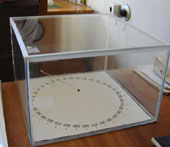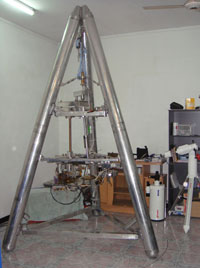 |
www.eclipse-chasers.com The Allais Effect Author: Thomas Goodey Last update: 7 JUL 2014 BK |
Eclipse-Chasers Menu Past eclipses Future eclipses |
The Allais Effect
Eclipse Chasing with a Pendulum
Solar eclipse chasers are not limited to visual devices and image recorders - some bring even more interesting equipment that you might not consider packing - such as pendulums. They are out to observe an elusive phenomenon that is known as the "Allais Effect".
Unlike diamond rings, strange shadows, horizon colors, and the corona - the Allais Effect is not easy to see, and even its existence is hotly disputed. You need to set up a delicate pendulum and observe it closely. And even the most diligent and enthusiastic experimenters have not seen the effect during all past eclipses.
Since the first claims in the 1950s when it was described as an anomalous effect, experimenters using pendulums have sporadically noted slight deviations when an eclipse is underway. Economic Nobel prize winner Maurice Allais first reported his observations in 1954, when he noted that the pendulum in his Paris laboratory demonstrated a slight change in the precession of its plane of oscillation. Repeating his experiment in 1959, he obtained similar results. Numerous scientists have attempted to recreate his experiment with some claiming success and others reporting no changes to the pendulum movement.
So exactly what is the observed anomaly?
The anomaly is that, around the time of the eclipse, there appears to be a change in the direction of the swing by a few degrees. If you leave a perfect pendulum running its plane of swing changes as the hours go by, due to the Foucault effect. Of course, you cannot build a perfect pendulum due to the frictions and drags associated with any real pendulum. Thus the experimenters reset and release their pendulum at regular intervals, recording the period of oscillation and noting the change of swing direction over time. The anomaly manifests itself as a disturbance of the speed at which the swing angle changes.
A change in the angular direction is expected. What has been seen, however, is an increase or decrease in the rate of that angular change around the time of a solar eclipse.
So how is this happening?
It is an anomaly. No one really has a satisfactory explanation for the observations. The most popular conventional theory is that mechanical flaws in the apparatus or a change in weather conditions is influencing the pendulum. Repeatability is important and unfortunately there have been few opportunities (needs a solar eclipse) with similar conditions (angles of observer to Moon and Sun, location on the Earth, etc.). What is needed is some way to detect the anomaly in non-eclipse conditions in a laboratory, and thus far this has not been done. So the best answer at this point as to how and why this is happening - indeed, as to whether it really happens at all - is simply to say we don't know.
Ongoing Research
Right now the only ongoing research is being performed by a dedicated group of individuals who set up elaborate devices at locations around solar eclipses. To minimize the influences of weather and the surroundings the apparatus is typically set up indoors on a solid floor with temperature and humidity controls.
This group is using several types of apparatus. The most complex is a short solid pendulum, about 1 meter long, suspended upon a small ball which rolls upon a flat piece of metal. This "ball-borne" pendulum was invented by Maurice Allais. Over the last five years, Thomas Goodey has been building and improving a portable robot operated ball-borne pendulum which he has transported to the sites of five solar eclipses so far, and now it is in the southern Maldives ready for his sixth eclipse.
YouTube Video of Pendulum in operation
YouTube Video of Robot Paraconical Pendulum
Another thread of the research is observations of longer pendulums. Prof. Rene Verreault of Quebec has been exploring this avenue. He uses an elliptical bob suspended with a wire 8 - 12 meters long, and observes and records its motion with a digital video-camera. The data is then processed with pattern recognition software to find the position and motion of the bob with very high accuracy.
 An alternative approach of using very delicate torsion balances has been pursued by Prof. Alexander Pugach of the Ukrainian Academy of Sciences. The arms of his balances weigh less than half a gram, and the suspension fibers are so thin that the restoring force is negligible. Groups of these balances have reacted in tandem during several solar and lunar eclipses.
An alternative approach of using very delicate torsion balances has been pursued by Prof. Alexander Pugach of the Ukrainian Academy of Sciences. The arms of his balances weigh less than half a gram, and the suspension fibers are so thin that the restoring force is negligible. Groups of these balances have reacted in tandem during several solar and lunar eclipses.
And Dimitrie Olenici has been working using pendulums of various lengths for almost a decade now.
This group appear to have seen something unusual during the 1 August 2008 eclipse, and have written a paper which can be read here:
http://www.allais.info/docs/pugarticle.pdf
Want to learn more?
The following web pages explain the anomaly in greater detail. Anyone who has seen an eclipse feels the power of the event. Most just get lost in the beauty of it all but one thing is for certain, the universe is full of surprises.
Summary article (by an 'anonymous' researcher at NASA, 1999):
http://science.nasa.gov/newhome/headlines/ast06aug99_1.htm
Overview of information (rather out of date now, but contains copies of a number of very interesting papers by past experimenters:
http://www.allais.info/
A Scientific overview of some data and approaches to anomalous eclipse experimentation:
http://arxiv.org/pdf/gr-qc/0408023v5

